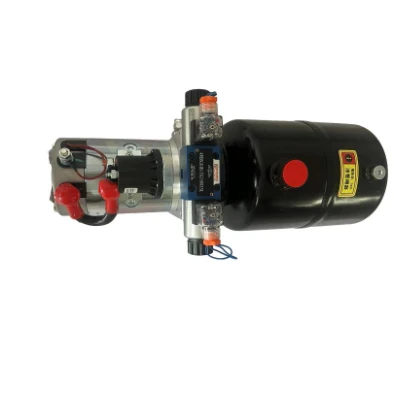Dec . 04, 2024 16:11 Back to list
flange hydraulic cylinder manufacturer
The Role of Flange Hydraulic Cylinder Manufacturers in Modern Industry
Hydraulic cylinders are pivotal components in many industrial applications, providing the necessary force and movement for various machines and tools. Among the different types of hydraulic cylinders, flange hydraulic cylinders are particularly notable for their robust design and versatile applicability. As we delve into the role of flange hydraulic cylinder manufacturers, it’s essential to understand the significance of these components in the industrial landscape, their specifications, and the dynamics of the manufacturing process.
Understanding Flange Hydraulic Cylinders
Flange hydraulic cylinders are characterized by their flanged ends, which facilitate easy mounting and dismounting. This design feature allows for more straightforward integration into hydraulic systems, making them an ideal choice for applications requiring frequent maintenance or replacement. The flanges provide strong structural integrity, ensuring that the cylinder can withstand high pressures while minimizing the risk of leaks.
The applications for flange hydraulic cylinders are varied, encompassing industries such as construction, manufacturing, agriculture, and automotive. From controlling the lift of an excavator's boom to enabling the pressing of materials in manufacturing, these cylinders play a crucial role in enhancing efficiency and productivity.
Key Specifications
When selecting a flange hydraulic cylinder, several key specifications must be considered
1. Pressure Rating This indicates the maximum pressure the cylinder can handle without risk of failure. High-pressure ratings are crucial for applications involving heavy lifting and demanding operational conditions.
2. Bore Size The diameter of the cylinder’s bore determines the amount of fluid that can be displaced, which directly relates to the force output. Choosing the right bore size is essential for achieving the desired performance.
3. Stroke Length This is the distance the piston travels within the cylinder. Custom stroke lengths can be produced to meet the specific needs of different applications.
4. Material The choice of materials affects durability and performance. Common materials for flange hydraulic cylinders include high-strength steel and corrosion-resistant alloys.
5. Seal Types Different seals determine the cylinder's ability to retain hydraulic fluid and prevent contamination. High-quality seals are essential for the longevity and efficiency of the hydraulic system.
The Manufacturing Process
flange hydraulic cylinder manufacturer

The process of manufacturing flange hydraulic cylinders is complex and requires precision engineering. Here are the key steps involved
1. Design The manufacturing process begins with detailed design specifications tailored to meet the specific needs of the end user. Computer-aided design (CAD) software is often utilized to create accurate blueprints.
2. Material Selection Manufacturers choose materials based on the desired specifications, taking into account factors such as strength, weight, and resistance to wear and corrosion.
3. Machining The chosen materials undergo a machining process where they are cut, shaped, and formed into the necessary components. This step requires high precision to ensure proper fit and function.
4. Assembly Following machining, the various components of the hydraulic cylinder are assembled. This includes the installation of the piston, seals, and flanges. Proper assembly techniques are critical to ensure the reliability and performance of the cylinder.
5. Testing Before the products are delivered to customers, they undergo rigorous testing to verify their performance under various pressures and conditions. This quality assurance step helps to minimize failures and ensure that the cylinders meet industry standards.
6. Finishing Finally, finishing processes such as painting or plating are applied to enhance the cylinder’s appearance and provide additional protection against environmental factors.
The Importance of Quality and Innovation
For flange hydraulic cylinder manufacturers, maintaining high-quality standards is paramount. Adhering to industry regulations and continuously innovating to improve designs and materials can set a manufacturer apart in a competitive marketplace. Customers seek reliability, durability, and efficiency, all of which hinge on the caliber of the manufacturer’s products.
Moreover, as industries become increasingly automated and demand for high-performance hydraulic systems grows, manufacturers are expected to stay ahead of technological advancements. Integrating smart technologies, such as IoT sensors for predictive maintenance, could further enhance the appeal and functionality of flange hydraulic cylinders.
Conclusion
Flange hydraulic cylinder manufacturers play a crucial role in the modern industrial landscape. By understanding the specifications, manufacturing processes, and the critical importance of quality, these manufacturers contribute significantly to the efficiency and effectiveness of various applications. As industries evolve, the demand for reliable and innovative hydraulic solutions will only grow, ensuring that flange hydraulic cylinder manufacturers remain integral to future developments.
-
Fork Lift Power Units - Hebei Shenghan | Efficiency, Reliability
NewsJul.13,2025
-
1.5-Ton Turbocharged Cylinder-Hebei Shenghan|Hydraulic Solution,Energy Efficiency
NewsJul.13,2025
-
Auto Hoist Power Units-Hebei Shenghan|Efficiency&Industrial Lifting
NewsJul.13,2025
-
Double Acting Power Units-Hebei Shenghan|Hydraulic Solutions,Industrial Efficiency
NewsJul.13,2025
-
1.5 Ton Lifting Cylinder 70/82-40-290-535 - High-Performance Hydraulic Solution | Hebei Shenghan
NewsJul.13,2025
-
Fork Lift Power Units - Hebei Shenghan | Efficiency&Reliability
NewsJul.13,2025
